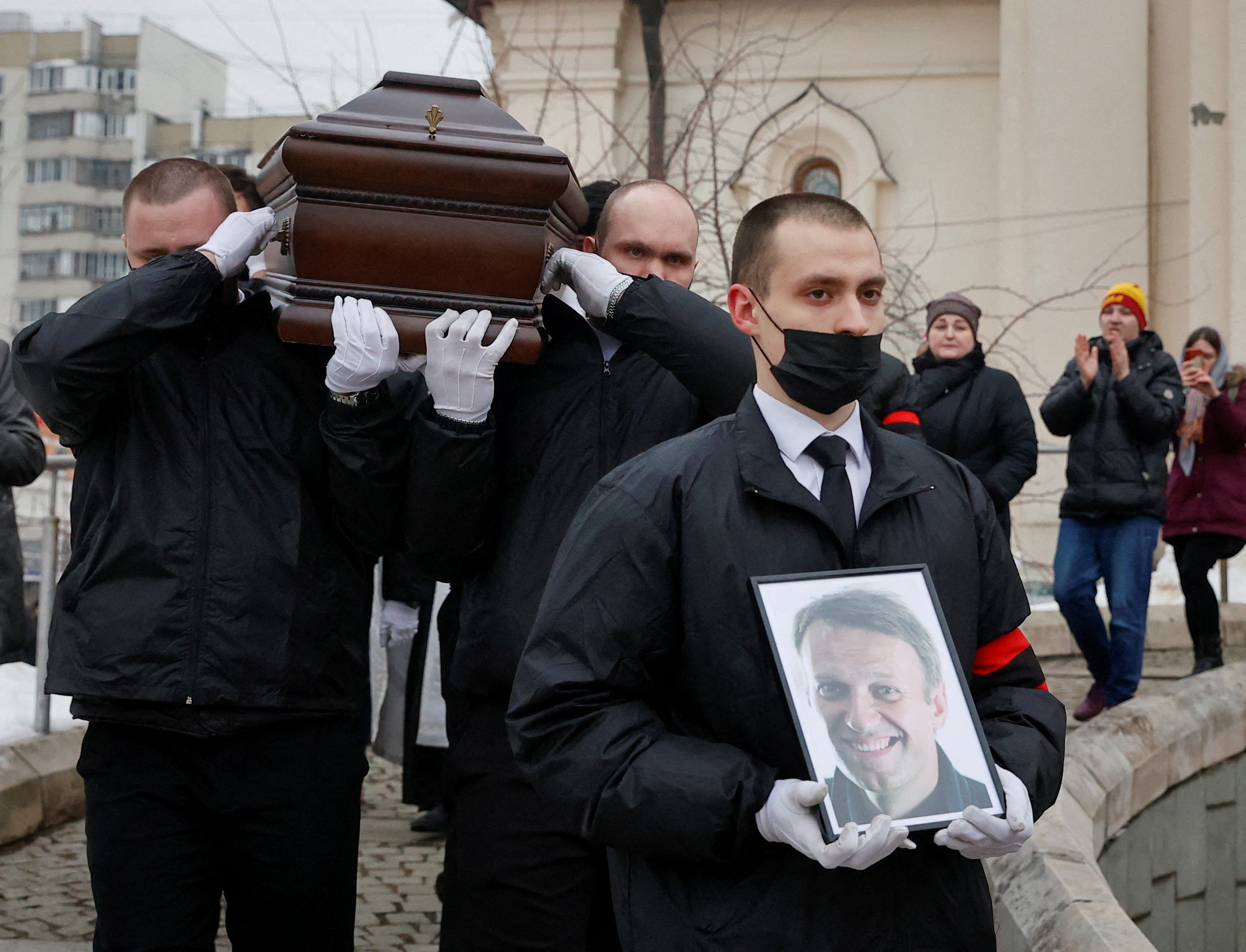The number of Russians who defied orders to stay away from Navalny’s funeral provide fresh hope
Despite all the warnings, despite knowing there would be a heavy police presence and their presence could have highly negative repercussions – even violent intervention from riot police – thousands turned out to pay their respects to Putin’s fiercest critic, writes Mary Dejevsky


Across Europe and America, thousands of people are laying flowers in memory of the man seen by many as the leader of Russia’s anti-Putin opposition and the hope, now extinguished, for its future.
Those performing this solemn commemorative ritual include politicians and campaigners, Russian expatriates and exiles – and many others longing for change in Russia, or just caught up in the loss of someone who has become a martyr for his cause.
This much was to be expected after Andrei Navalny’s now vestigial campaign team called on those who had no other way of paying their respects to lay flowers at a site of their choice at 7pm, Moscow time, on the day of his funeral.
Less expected – and in fact quite extraordinary, however – were the number of Russians, in Russia, who also answered the appeal to lay flowers. Most extraordinary of all, though, was how many Russians made their way to the funeral and burial in Moscow, despite all the warnings, despite knowing there would be a heavy police presence and that, at very least, their presence could have highly negative repercussions for their prospects. That was even without the likelihood of violent intervention from the riot police.
In the event, only a very small number of people were admitted to the church, the mobile phone signal was blocked – which restricted the Navalny team’s plans for live-streaming – and the authorities had erected fences all the way around the huge cemetery to limit access for mourners.
One way or another, however, many did get in, and the burial plot was close to the entrance and visible from the road. A British television crew – commended by the Navalny live-streamers for their enterprise – managed to get their camera through the cemetery railings and record the closing of the coffin and the strains of the chosen music, which included “My Way”.
For many hours, even days, it was almost dizzying how many facets of today’s Russia were at once on display, running the gamut from the age-old Russian Orthodox funeral rites, through the diabolically inventive discouragements typical of Soviet times, to the raw politics of today, which suddenly burst out from the censorship imposed after Russia’s invasion of Ukraine.
As the funeral bells tolled, the thousands-strong crowds waved their flowers in the air and chanted Navalny’s name. But not only his name. “You were not afraid. We are not afraid”, was among the first of the chants, followed by “Russia will be free,” and “We will not forget.”
As they grew bolder, they sang out the chant that accompanied the 2012 protests against Vladimir Putin’s return to the presidency – “Russia without Putin” – the street protests first associated with Navalny.
There was also a smattering of “No to the war”, which Navalny’s live-streaming presenters pointed out sounds (in Russian) pretty like “Navalny”.
Funerals can be profoundly political occasions, with the potential to threaten entrenched power. The memorial for the reforming Chinese leader, Hu Yaobang, precipitated the student protests that culminated in the military assault on Tiananmen Square.
The funeral of the Soviet nuclear scientist and human rights campaigner, Andrei Sakharov, gave a new impetus to the ultimately successful movement to abrogate Article 6 of the Soviet constitution that guaranteed the “leading role” of the Communist Party.
And don’t forget the funeral of Princess Diana – the carpets of flowers and the unprecedented applause from the crowd gathered outside Westminster Abbey for the oration of her brother, Charles Spencer, that could be heard, and understood by the congregation inside.
While the religious ritual will be familiar to most Russians, many non-Russians of a certain age will also know something of the evocative quality of a Russian funeral from the opening sequences of David Lean’s film of Boris Pasternak’s Doctor Zhivago.
The sad procession across a wintry landscape from church to cemetery with the haunting strains of the orthodox funeral chants carried on the wind. The funeral of Navalny, a new-style campaigner with a Russian nationalist streak, was always going to reflect both elements.
And the authorities had been true to form in advance. They had strewn every possible obstacle in the path of Navalny’s family and campaign staff, just as their Soviet predecessors knew so well how to do.
They delayed releasing his body from the hospital morgue where he had been taken from his Arctic prison camp. His doughty mother – from the mould of the tough women who had followed their menfolk into Siberian exile – started legal proceedings. She defied warnings to keep the funeral private, and insisted it be held in Moscow. There was difficulty finding a venue for the funeral and hiring a hearse.
Access to the funeral was made as difficult and as intimidating as it could be – and yet, in the end, the funeral and the burial happened anyway. Much of the proceedings was live-streamed, and so accessible in Russia and around the world. On the day, it seemed, the authorities were prepared to go so far, but no further – although it remains to be seen how they decide to proceed in the days and weeks to come.
If, as is likely, Navalny’s grave now becomes a place of pilgrimage, at least for a few weeks, how tolerant will the Kremlin be? Probably not very.
Navalny has stirred a resistance in Russia, and left a legacy for others to work with. Whether it is his widow, Yulia, who takes on his cause, as she has pledged to do, or others, hardly matters at this point.
What we have seen is a country straddled between its past and its future with almost as many contradictions and uncertainties as there were in the few years before the Soviet collapse. But it is not a country without hope, or a country whose sole bearer of hope has died.
The thousands who turned out in a snowy Moscow to demand their right to say goodbye counter a version of Russia as a monolith stamped into conformity and of Russians as people with no spirit, variety or purpose of their own, beyond the diktats issued from inside the Kremlin walls.
In two weeks’ time, Russians will vote in an election that many see as a sham and is almost certain to extend Putin’s presidential mandate for another six years.
When that happens, it might be worth revisiting the live-stream of Navalny’s funeral and considering not what might have been, but what is still likely to be. People defied official edicts; the technology was able, for the most part, to circumvent state media restrictions, and there were individuals willing and able to use it. This is not a country that needs to lose hope.






Join our commenting forum
Join thought-provoking conversations, follow other Independent readers and see their replies
Comments